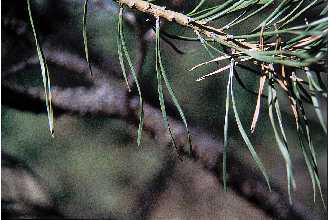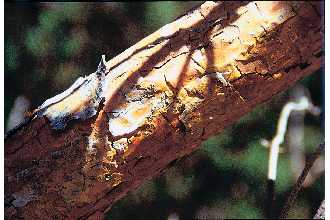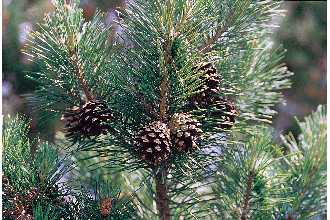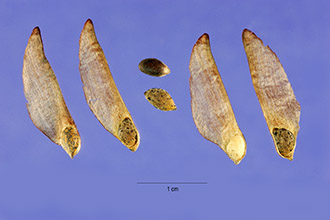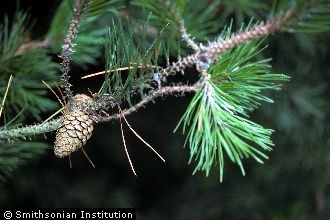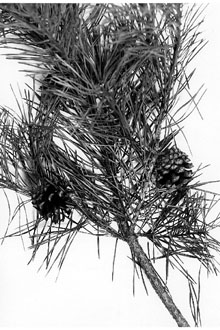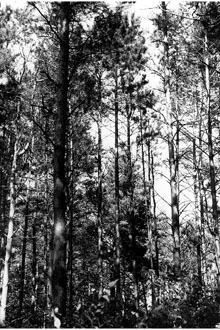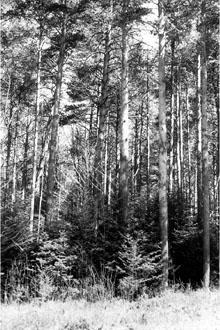Scots Pine
Scientific Name: Pinus sylvestris L.
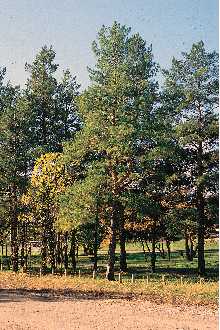
| General Information | |
|---|---|
| Usda Symbol | PISY |
| Group | Gymnosperm |
| Life Cycle | Perennial |
| Growth Habits | Tree |
| Native Locations | PISY |
Plant Guide
Use soil moisture sensors to measure the soil moisture of Scots Pine.
Fact Sheet
Uses
Windbreaks: Plant Scots pine in the central or leeward rows of multi-row plantings. It is also recommended for planting as single-row windbreaks. Wildlife: Scots pine is of some importance as food and cover for many birds and small mammals. Although the plant is browsed by whitetail and mule deer, it is not a preferred forage. Timber/Christmas tree plantations: Scots pine is suitable for ornamental and screen plantings. Its year long coloration adds variety to recreation plantings.
Status
Please consult the PLANTS Web site and your State Department of Natural Resources for this plant’s current status (e.g. threatened or endangered species, state noxious status, and wetland indicator values).
Description
Scots pine is an evergreen, spreading tree 80 to 100 feet, pyramidal when young, becoming round topped and irregular in age. The tree is introduced from Eurasia, and has become naturalized in eastern North America. It is cultivated for windbreaks, timber, and Christmas tree plantations. It does best on rich, moist soils, but its winter hardiness and moderate drought tolerance enable it to do well on other soils. It is moderately slow growing, but is long lived. Description Fruits are tawny-yellow, oblong, symmetrical cones, 1 to 2 inches long. Clusters of flowers are yellow, minute, male and female. Needles occur in bunches of 2, are stout and usually twisted, 1 to 3 inches long, and bluish-green in color. Scots pine branches are spreading, and stems are often crooked in early years. The plant’s bark is orange, thin and smooth on upper trunk, dark and fissured below. The tree’s root system is widespread, moderately deep, and wind-firm.
Adaptation and Distribution
Distribution
Distribution
Scots pine is distributed throughout the Northeast and upper Midwest. For a current distribution map, please consult the Plant Profile page for this species on the PLANTS Website. Establishment USDA NRCS National Plant Materials Center Beltsville, MD Plantings should be established during the spring of the year on weed free sites. Stand establishment can be enhanced by using 2 year old field-grown stock. Holes or furrows should be deep enough to contain roots without bending.
Management
Weed control is recommended in areas where the tree is grown for shade or Christmas tree plantings, It is also good to shape the tree for the form that you would like to have at time of harvest, , Use soil moisture sensors to measure the soil moisture of Scots Pine.
Plant Traits
Growth Requirements
| Temperature, Minimum (°F) | -36 |
|---|---|
| Adapted to Coarse Textured Soils | Yes |
| Adapted to Fine Textured Soils | No |
| Adapted to Medium Textured Soils | Yes |
| Anaerobic Tolerance | Medium |
| CaCO3 Tolerance | Low |
| Cold Stratification Required | Yes |
| Drought Tolerance | Medium |
| Fertility Requirement | Medium |
| Fire Tolerance | Low |
| Frost Free Days, Minimum | 120 |
| Hedge Tolerance | Medium |
| Moisture Use | Medium |
| pH, Maximum | 7.5 |
| pH, Minimum | 5.0 |
| Planting Density per Acre, Maxim | 1200 |
| Planting Density per Acre, Minim | 430 |
| Precipitation, Maximum | 45 |
| Precipitation, Minimum | 24 |
| Root Depth, Minimum (inches) | 20 |
| Salinity Tolerance | Low |
| Shade Tolerance | Intolerant |
Morphology/Physiology
| Bloat | None |
|---|---|
| Toxicity | None |
| Resprout Ability | No |
| Shape and Orientation | Conical |
| Active Growth Period | Spring and Summer |
| C:N Ratio | High |
| Coppice Potential | No |
| Fall Conspicuous | No |
| Fire Resistant | No |
| Flower Conspicuous | No |
| Foliage Color | Green |
| Foliage Porosity Summer | Dense |
| Foliage Porosity Winter | Dense |
| Foliage Texture | Medium |
| Fruit/Seed Conspicuous | No |
| Nitrogen Fixation | None |
| Low Growing Grass | No |
| Lifespan | Moderate |
| Leaf Retention | Yes |
| Known Allelopath | No |
| Height, Mature (feet) | 110.0 |
| Height at 20 Years, Maximum (fee | 30 |
| Growth Rate | Rapid |
| Growth Form | Single Stem |
| Fruit/Seed Color | Brown |
Reproduction
| Vegetative Spread Rate | None |
|---|---|
| Small Grain | No |
| Seedling Vigor | Medium |
| Seed Spread Rate | Slow |
| Seed per Pound | 70720 |
| Fruit/Seed Persistence | No |
| Propagated by Tubers | No |
| Propagated by Sprigs | No |
| Propagated by Sod | No |
| Propagated by Seed | Yes |
| Propagated by Corm | No |
| Propagated by Cuttings | No |
| Bloom Period | Mid Spring |
| Commercial Availability | Routinely Available |
| Fruit/Seed Abundance | High |
| Fruit/Seed Period Begin | Summer |
| Fruit/Seed Period End | Fall |
| Propagated by Bare Root | Yes |
| Propagated by Bulb | No |
| Propagated by Container | Yes |
Suitability/Use
| Veneer Product | No |
|---|---|
| Pulpwood Product | Yes |
| Protein Potential | Low |
| Post Product | No |
| Palatable Human | No |
| Palatable Graze Animal | Low |
| Palatable Browse Animal | Low |
| Nursery Stock Product | Yes |
| Naval Store Product | No |
| Lumber Product | No |
| Fuelwood Product | Medium |
| Fodder Product | No |
| Christmas Tree Product | Yes |
| Berry/Nut/Seed Product | No |

